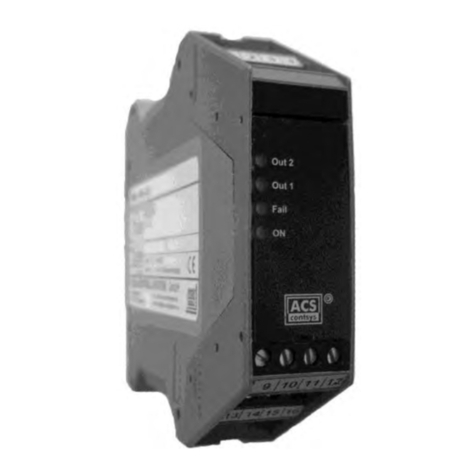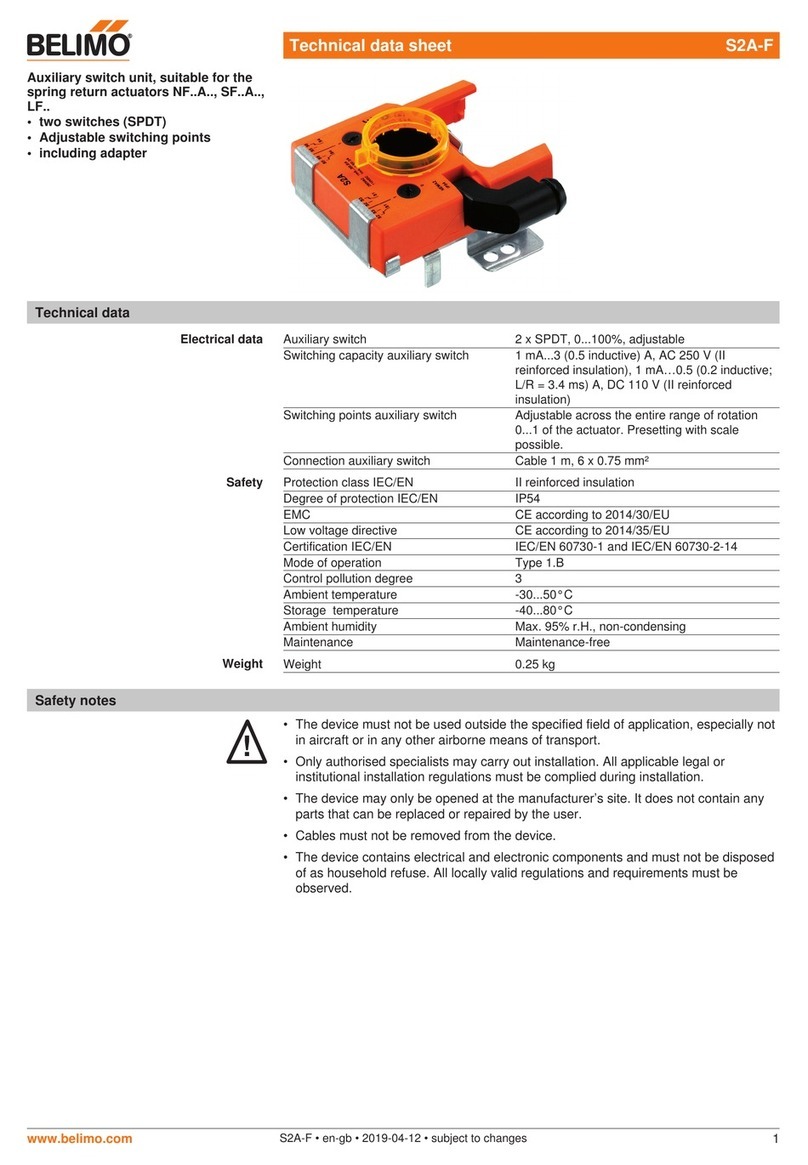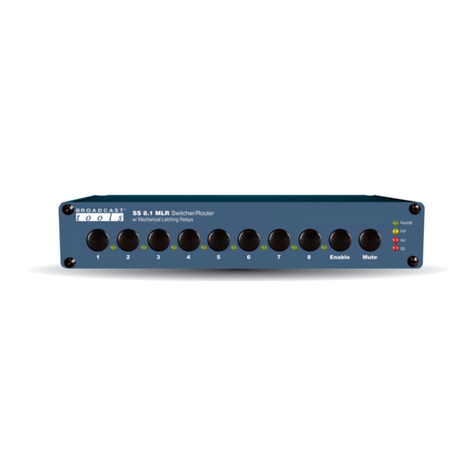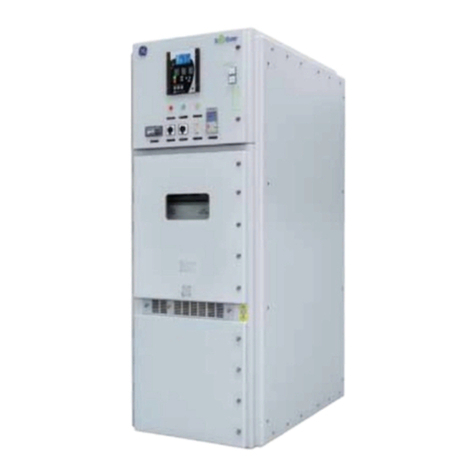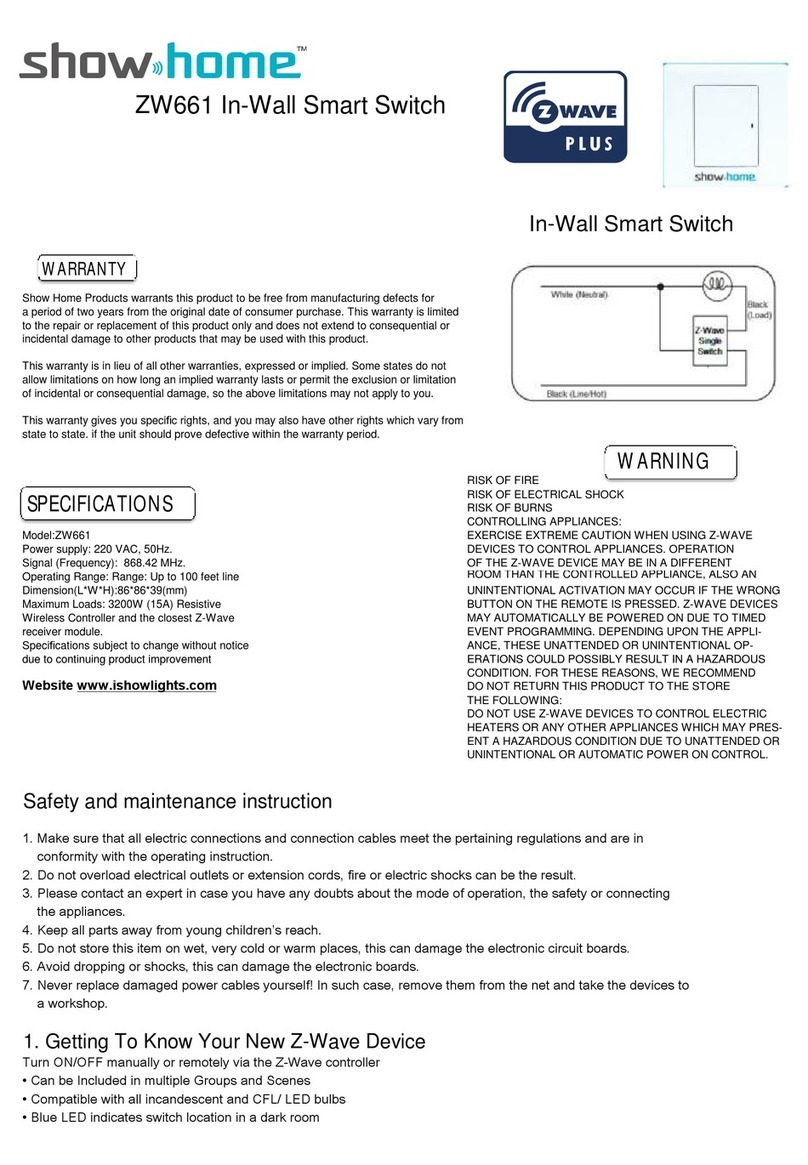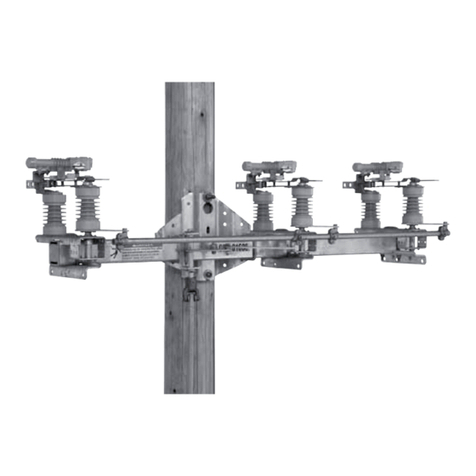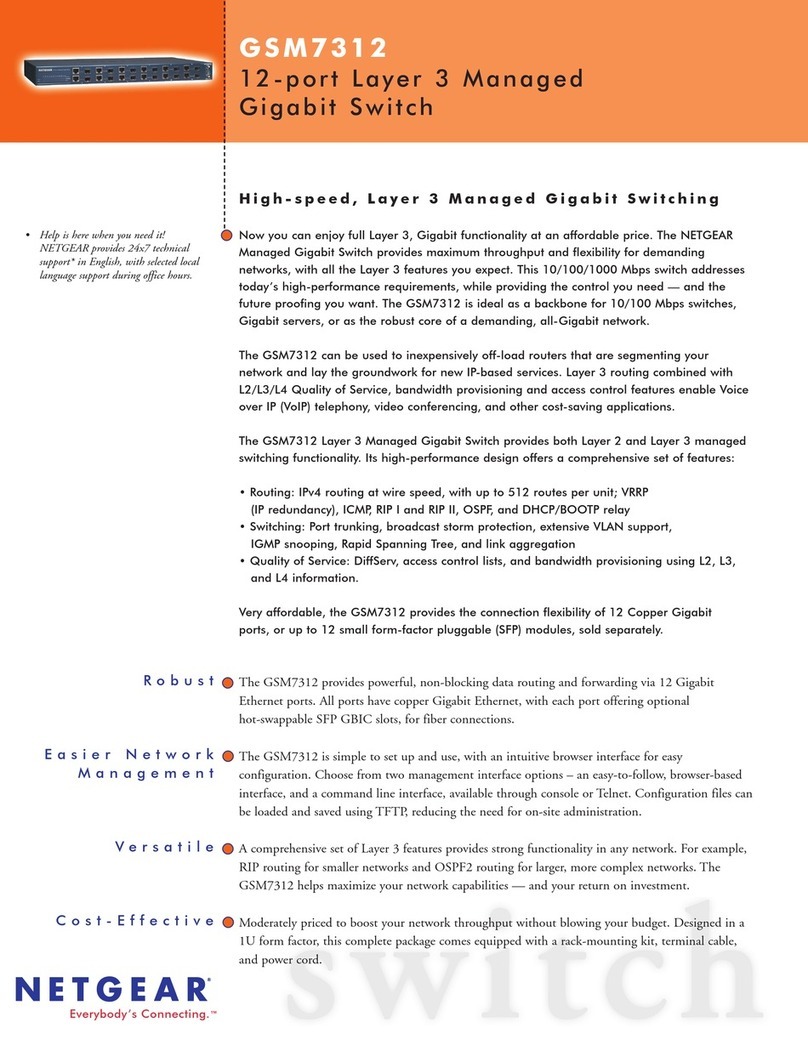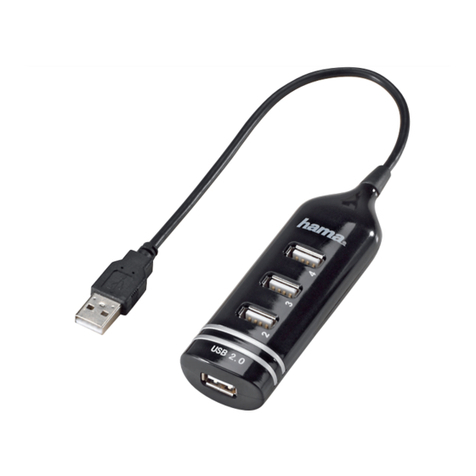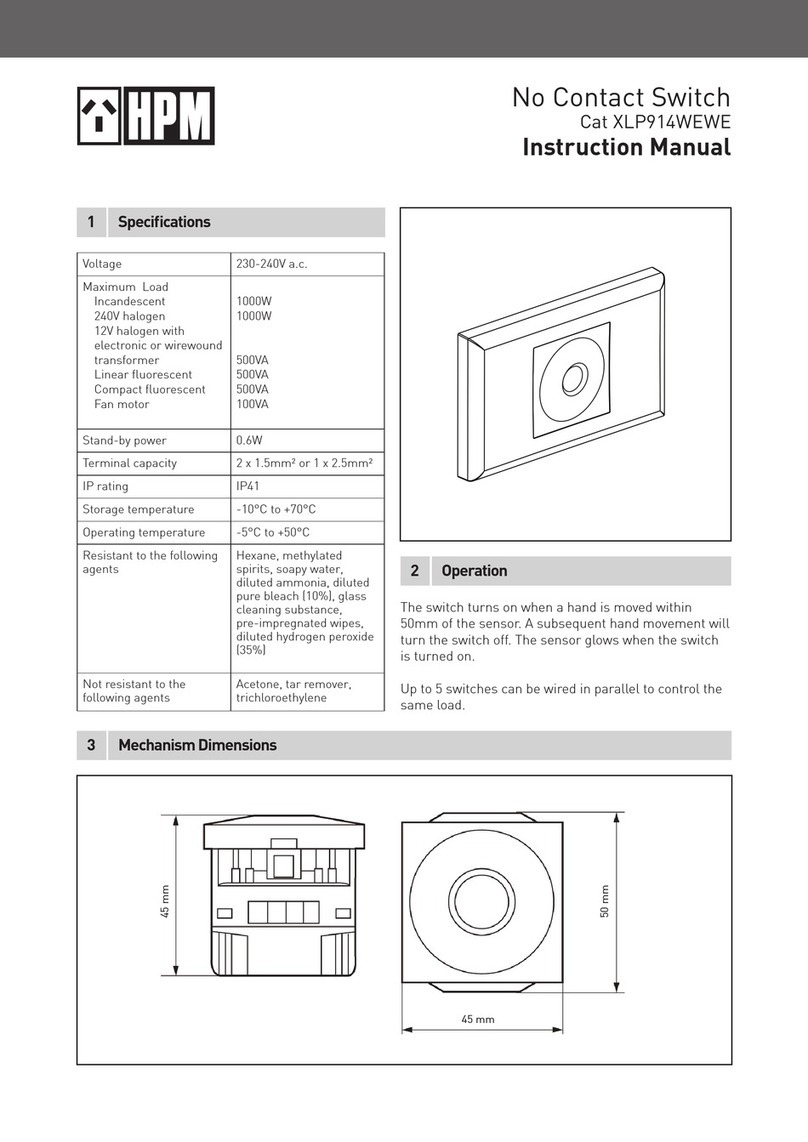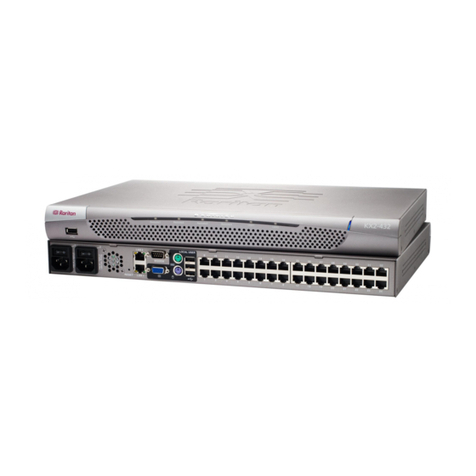Belimo NFB Series Guide

General Information
Application
For On/Off, VDC, programmable MFT, fail-safe control of
dampers in HVAC systems. Actuator sizing should be
done in accordance with the damper manufacturer’s
specifications. Control can be on/off, 2-10 VDC or
programmable MFT.
The actuator is mounted directly to a damper shaft up to
1.05” in diameter by means of its universal clamp. A
crankarm and several mounting brackets are available
for applications where the actuator cannot be direct
coupled to the damper shaft.
Operation
The NFB, NFX series actuators provide true spring return
operation for reliable fail-safe application and positive
close off on air tight dampers. The spring return system
provides consistent torque to the damper with, and
without, power applied to the actuator.
The NFB, NFX series provides 95° of rotation and is
provided with a graduated position indicator showing
-0° to 95°. The NFB, NFX series has a unique manual
positioning mechanism which allows the setting of any
damper position within its 95° of rotation. The actuator
is shipped in the zero position (5° from full fail-safe) to
provide automatic compression against damper gaskets
for tight shutoff. When power is applied, the manual
mechanism is released. The actuator will now try to
close against the -5° position during its normal control
operations. The manual override can also be released
physically by the use of a crank supplied with the
actuator.
The NFB, NFX series use a brushless DC motor which is
controlled by an Application Specific Integrated Circuit
(ASIC). The ASIC monitors and controls the actuator’s
rotation and provides a digital rotation sensing function
to prevent damage to the actuator in a stall condition.
The actuator may be stalled anywhere in its normal
rotation without the need of mechanical end switches.
The NFB…-S, NFX…-S versions are provided with two
built in auxiliary switches. These SPDT switches are
provided for safety interfacing or signaling, for example,
for fan start-up. The switching function at the fail-safe
postion is fixed at 10°, the other switch function is
adjustable between 10° to 90°.
Features
• On/Off, 2-10 VDC, Variable MFT, Spring Return, 24 VAC
or 24 VDC, 120 VAC-240 VAC
• 90 in-lb min. torque, for control of air dampers
Mounting Installation Instructions
NFB, NFX Series
®
71199-00001.A
Dimensions (Inches [mm])
K7-2 (supplied)
1/2" Centered
(Default)
3/4" Centered
(Field Selectable)
1.05" Centered
(Field Selectable)

CCW
CCW
2
Installation Instructions
Quick-Mount Visual Instruction for Mechanical Installation
®
min. 3 1/2” [90]
min. 3/4” [20]
1/4" [6.35 mm]
1/4" [6.35 mm]
1/4" [6.35 mm]
CCW
CCW
CW
CW
1/4" [6.35 mm]
CW
CW
.2
.8
CCW CW
35° ... 95°
9
1. Rotate the damper to its fail-safe position.
If the shaft rotates counterclockwise, mount the “CCW” side of the actuator out.
If it rotates clockwise, mount the actuator with the “CW” side out.
2. If the universal clamp is not on the correct side of the actuator, move it to the correct side for ease of installation.
3. Slide the actuator onto the shaft and tighten the nuts on the V-bolt with a 10mm wrench to 6-8 ft-lb of torque.
4. Slide the anti-rotation strap under the actuator so that it engages the slot at the base of the actuator. Secure the
strap to the duct work with #8 self-tapping screws.
Standard Mounting

3
Installation Instructions
K7-2 Universal Clamp
®
1
2

Installation Instructions
Mechanical Installation
®
4
Determining Torque Loading and Actuator Sizing
Damper torque loadings, used in selecting the correct size
actuator, should be provided by the damper manufacturer.
If this information is not available, the following general
selection guidelines can be used.
Damper Type Torque Loading
Opposed blade, without edge
seals, for non-tight close-off
applications
3 in-lb/sq. ft.
Parallel blade, without edge seals,
for non-tight close-off applications 4 in-lb/sq. ft.
Opposed blade, with edge seals,
for tight close-off applications 5 in-lb/sq. ft.
Parallel blade, with edge seals, for
tight close-off applications 7 in-lb/sq. ft.
The above torque loadings will work for most applications
with 1000 FPM face velocity. For applications between this
criteria and 2500 FPM, the torque loading should be
increased by a multiplier of 1.5. If the application calls for
higher criteria up to 3000 FPM, use a multiplier of 2.0.
General Information
Belimo actuators should be mounted indoors in a dry,
relatively clean environment free from corrosive fumes. If
the actuator is to be mounted outdoors, a protective
enclosure must be used to shield the actuator.
For new construction work, order dampers with extended
shafts. Instruct the installing contractor to allow space for
mounting and service of the Belimo actuator on the shaft.
The damper shaft must extend at least 3 1/2” from the
duct. If the shaft extends less than 3-1/2” or if an
obstruction blocks access, the shaft can be extended with
the AV 8-25 shaft extension accessory or the actuator
may be mounted in its short shaft configuration.
Mechanical Operation
The actuator is mounted directly to a damper shaft up to
1.05” in diameter by means of its universal clamp. A crank
arm and several mounting brackets are available for
applications where the actuator cannot be direct coupled
to the damper shaft. The NFB, NFX series actuators
provide true spring return operation for reliable fail-safe
application and positive close-off on air tight dampers. The
spring return system provides constant torque to the
damper with, and without, power applied to the actuator.
The NFB…-S, NFX…-S versions are provided with two
built-in auxiliary switches. These SPDT switches are
provided for safety interfacing or signaling, for example,
for fan start-up. The switching function at the fail-safe
position is fixed at +10°, the other switch function is
adjustable between +10° to +90°.
Standard Mounting
NOTE: The NFB, NFX…series actuator is shipped
with the manual override adjusted for a +5° position
at the universal clamp (not at full fail-safe, 0°). This
allows for automatic compression of damper blade
seals when the actuator is in use, providing tight
shut-off. This assumes that the damper is to have
tight shut-off at the fail-safe position. If tight close-
off is desired at the opposite direction from fail-safe,
the manual override should be released so the
actuator can go to the full fail-safe position. See the
manual override instructions.
1. Manually move the damper to the fail-safe position
(usually closed). If the shaft rotated counterclockwise
(), this is a CCW installation. If the shaft rotated
clockwise ( ), this is a CW installation. In a CCW
installation, the actuator side marked “CCW” faces out,
while in a CW installation, the side marked “CW” faces
out. All other steps are identical.
2. The actuator is usually shipped with the universal
clamp mounted to the “CCW” side of the actuator. To
test for adequate shaft length, slide the actuator over
the shaft with the side marked “CCW” (or the “CW”
side if this is the side with the clamp). If the shaft

5
Installation Instructions
Mechanical Installation
®
extends at least 1/8” through the clamp, mount the
actuator as follows. If not, go to the Short Shaft
Installation section.
3. If the clamp is not on the correct side as determined
in step #1, re-mount the clamp as follows. If it is on
the correct side, proceed to step #5. Look at the
universal clamp. If you are mounting the actuator with
the “CCW” side out, position the clamp so that the
pointer section of the tab is pointing to 0° (see Figure
C) and the spline pattern of the clamp mates with
spline of the actuator. Slip the clamp over the spline.
(Use the same procedure if the “CW” side is out.) If
your application requires a mechanical minimum
position, read the Rotation Limiting, Mechanical
Minimum Damper Position section.
4. Lock the clamp to the actuator using the retaining
clip.
5. Verify that the damper is still in its full fail-safe
position.
6. Slide the actuator over the shaft.
7. Position the actuator in the desired location.
8. Tighten the two nuts on the clamp using a 10mm
wrench or socket using 6-8 ft-lb of torque.
9. Slip the stud of the anti rotation strap into the slot at
the base of the actuator. The stud should be
positioned approximately 1/16 of an inch from the
closed end of the slot. Bend the strap as needed to
reach the duct. Attach the strap to the duct with #8
self tapping screws.
Short Shaft Installation
If the shaft extends at least 3/4” from the duct, follow
these steps:
1. Determine the best orientation for the universal
clamp on the back of the actuator. The best location
would be where you have the easiest access to the V
bolt nuts on the clamp.
2. Engage the clamp to the actuator as close as
possible to the determined location.
3. Lock the clamp in place using the remaining retainer
clip.
4. Verify that the damper is still in its full fail-safe
position.
5. Slide the actuator over the shaft.
6. Position the actuator in the desired location.
7. Tighten the two nuts on the clamp using a 10mm
wrench or socket using 6-8 ft-lb of torque.
8. Slip the stud of the anti-rotation strap into the slot at
the base of the actuator. The stud should be
positioned approximately 1/16 of an inch from the
closed end of the slot. Bend the strap as needed to
reach the duct. Attach the strap to the duct with #8
self tapping screws.
9. If damper position indication is required, use the
optional IND-AFB pointer. See Figure A.
Jackshaft Installation
The NFB, NFX… series actuator is designed for use with
jackshafts up to 1.05” in diameter. In most applications,
the NFB, NFX actuator may be mounted in the same
manner as a standard damper shaft application. If more
torque is required than one NFB, NFX actuator can
provide, refer to AFB, AFX or AF series actuators.
9
8
7
6
5
43210
9
8
7
6
5
43210
9
8
7
6
5
4
3
2
1
0
9
8
7
6
5
4
3
2
1
0
Figure A
Correct clamp
mounting
position if
actuator is at
full fail-safe.
Correct pointer
mounting
position if
actuator is at
full fail-safe.
9
8
7
6
5
43210
9
8
7
6
5
43210
9
8
7
6
5
4
3
2
1
0
9
8
7
6
5
4
3
2
1
0
Correct clamp
mounting
position if
actuator is at
5° preload.
Correct pointer
mounting
position if
actuator is at
5° preload.

6
Installation Instructions
Mechanical Installation
®
Rotation Limitation
The angle of rotation limiter, which is built into the
actuator, is used in conjunction with the tab on the
universal clamp or IND-AFB position indicator. In order to
function properly, the clamp or indicator must be mounted
correctly.
See Figure A.
The rotation limiter may not work in certain mounting
orientations using the ZG-118 mounting bracket. Limiting
the damper rotation must be accomplished by adjusting
the crank arm linkage.
The built-in rotation limiter may be used in 2 ways to
control the rotational output of the NFB, NFX series
actuator. One use is in the application where a damper has
a designed rotation less than 90°. An example would be a
45° or 60° rotating damper. The other application would
be to set a minimum damper position which can be easily
set or changed without having to remove the actuator
from the damper.
Damper Rotation Limiting
1. Determine the amount of damper rotation required.
2. Locate the Angle of Rotation Limiter on the actuator
Figure B.
3. Position the limiter to the desired position, making
sure the locating “teeth” on the limiter are engaged
into the locating holes on the actuator.
4. Fasten the limiter by screwing the attached screw.
5. Test the damper rotation either manually with the
manual crank or apply power and if required, a
control signal. Re-adjust if necessary.
FIGURE B
9
Philips screwdriver
Z-AF for Replacing AF and NF Actuators

7
Installation Instructions
Mechanical Installation
®
The NFB, NFX series actuators can be manually
positioned to ease installation or for emergency
positioning.
1. The manual override will only work if no power is
available to the actuator.
2. Insert the manual crank (shipped with the actuator)
into the hexagon hole located on either side of the
actuator. An illustration, located on the label, shows
the location.
3. Turn the crank in the direction shown on the label
(clockwise on the “CW” side, counterclockwise on the
“CCW” side). It will take approximately 23 revolutions
to rotate the full 95° of rotation.
4. To lock the actuator in the required position, flip the
switch to the locked position that is located to the
right of the crank on the CCW side of the actuator (left
of the crank on the CW side).
5. The manual override may be disengaged in 2 ways.
- Flip the switch to the unlocked position and the
actuator will go to its fail-safe position.
- Apply power to wire 1 and 2. The actuator will
automatically disengage the override function and
will go to the “on” position in the case of the On/
Off versions. Or, in the case of the proportional
versions, go to the 0 signal position and then go to
the position corresponding to the control signal.
The actuator will now work normally.
CCW Side Example:
Manual Override
The actuator/damper installation may be tested without
power at the actuator. Refer to the manual positioning
section of the instructions. Move the damper to its full
non-fail-safe position using the manual crank. Disengage
the manual position mechanism and have the damper go
to full fail-safe position. Correct any mechanical
problems and retest.
Testing the Installation Without Power
Winding the damper actuator
- insert crank handle
- turn handle in direction of arrow
Locking the damper actuator
- Flip the lock switch to the position pointing to the
“locked” symbol
Unlocking the damper actuator
(2 options)
- Flip the lock switch to the position pointing to the
“unlocked” symbol.
- Remote control by supplying power to the unit for
> than 3 sec.
Auxiliary Switches
The NFB, NFX series actuators may be ordered with 2
built-in SPDT auxiliary switches used for safety
interfacing or signaling, for example, for fan start-up. The
switch position near the fail-safe position is fixed at 10°.
The other is adjustable between 10° and 90° of rotation.
The crank that is supplied with the actuator is used to
change the switch position.
SWITCH RATING
Voltage Resistive Load Inductive Load
120 VAC 3A 1.03A
250 VAC 3A 0.5A
Two methods may be used to adjust the switching point of
the adjustable switch.
Method 1 - See Figure F
1 The actuator must be in its fail-safe position.
2. Insert the crank handle into the torx shaped hole
located in the center of the adjustable switch pointer.
3. Gently rotate the crank until the switch pointer is at
the desired switch point in degrees as shown.
NFB, NFX... Series
.2
.4
.6
.8
.2
.4
.6
.8
.2
.4
.6
.8
FIGURE F

8
Installation Instructions
Mechanical Installation and Non-Direct Mounting Methods
®
Method 2 - See Figure G
1. Position the damper to the point at which you want
the switch to activate. This may be done by using the
manual override or by providing the appropriate
proportional signal to NFB24, NFX24… modulating
type actuator. The position of the switch pointer is not
important during this step
2. Insert the crank into the hexagon shaped hole located
in the center of the adjustable switch pointer.
3. Gently rotate the switch pointer to just past the switch
point indicating arrow as shown.
NFB, NFX... Series
.2
.4
.6
.8
.2
.4
.6
.8
.2
.4
.6
.8
FIGURE G
KH-AFB Crank Arm
Including Retaining Ring
CAUTION: The retaining clip supplied with the clamp is
not used to mount the KH-AFB crank arm.
The KH-AFB crank arm is used in non-direct coupled
mounting applications.
The KH-AFB may also be used to simultaneously direct
couple to a damper shaft and provide an additional crank
arm connection to a second damper.
KH-AFB For round shafts up to 3/4” or square
shafts up to 5/8”
KH-AFB non-direct mounting with ZG-118 mounting bracket
Dimensions (Inches [mm])
Vorlage_ Klappenhebel 3-4 Zoll

9
Installation Instructions
Electrical Operation
®
The NFB, NFX series actuators utilize both DC Motors
and brushless DC motor technology. The NFB, NFX uses
this motor in conjunction with an Application Specific
Integrated Circuit (ASIC). In the On/Off versions of the
NFB and NFX, the ASIC monitors and controls the
actuator’s rotation and a digital rotation sensing function
to prevent damage to the actuator. The NFB24, NFX24…
modulates type actuators incorporate a built in
microprocessor. The microprocessor provides the
intelligence to the ASIC to provide a constant rotation
rate and knows the actuator’s exact zero position.
Belimo’s brushless DC motor spins by reversing the
poles of stationary electromagnets housed inside of a
rotating permanent magnet. The electromagnetic poles
are switched by a special ASIC circuit developed by
Belimo. Unlike the conventional DC motor, there are no
brushes to wear or commutators to foul.
The NFB, NFX series actuators are protected from
overload at all angles of rotation. The ASIC circuit
constantly monitors the rotation of the DC motor inside
the actuator and stops the pulses to the motor when it
senses a stall condition. The DC motor remains
energized and produces full rated torque to the load.
This helps ensure that dampers are fully closed and that
edge and blade seals are always properly compressed.
Belimo brushless DC motors eliminate the need for
potentiometers for positioning in modulating type
actuators. Inside the motor are three “Hall Effect”
sensors. These sensors detect the spinning rotor and
send pulses to the microprocessor which counts the
pulses and calculates the position to within 1/3 of a
revolution of the motor.
General
Brushless DC Motor Operation
Overload Protection
Motor Position Detection
Control Accuracy and Stability
NFB24-MFT, NFX24-MFT actuators have built-in
brushless DC motors which provide better accuracy and
longer service life.
The NFB24-MFT, NFX24-MFT actuators are designed with
a unique non-symmetrical deadband. The actuator follows
an increasing or decreasing control signal with a 80 mV
resolution. If the signal changes in the opposite direction,
the actuator will not respond until the control signal
changes by 200 mV. This allows these actuators to track
even the slightest deviation very accurately, yet allowing
the actuator to “wait” for a much larger change in control
signal due to control signal instability.
8
8
Note: Resolution is a percentage of operating range. 1%
in one direction, 2.5% when changing direction. 2-10 VDC
control example shown above.

Installation Instructions
General Wiring Instructions
®
10
WARNING The wiring technician must be trained and
experienced with electronic circuits. Disconnect power
supply before attempting any wiring connections or
changes. Make all connections in accordance with
wiring diagrams and follow all applicable local and
national codes. Provide disconnect and overload
protection as required. Use copper, twisted pair,
conductors only. If using electrical conduit, the
attachment to the actuator must be made with flexible
conduit.
Always read the controller manufacturer's installation
literature carefully before making any connections.
Follow all instructions in this literature. If you have any
questions, contact the controller manufacturer and/or
Belimo.
Transformers
The NFB24, NFX24…actuators require a 24 VAC class 2
transformer and draws a maximum of 10 VA per actuator.
The actuator enclosure cannot be opened in the field,
there are no parts or components to be replaced or
repaired.
– EMC directive: 89/336/EEC
– Software class A: Mode of operation type 1
– Low voltage directive: 73/23/EEC
CAUTION: It is good practice to power electronic or
digital controllers from a separate power transformer
than that used for actuators or other end devices. The
power supply design in our actuators and other end
devices use half wave rectification. Some controllers use
full wave rectification. When these two different types of
power supplies are connected to the same power
transformer and the DC commons are connected
together, a short circuit is created across one of the
diodes in the full wave power supply, damaging the
controller. Only use a single power transformer to power
the controller and actuator if you know the controller
power supply uses half wave rectification.
Multiple Actuators, One Transformer
Multiple actuators may be powered from one transformer
provided the following rules are followed:
1. The TOTAL current draw of the actuators (VA rating) is
less than or equal to the rating of the transformer.
2. Polarity on the secondary of the transformer is strictly
followed. This means that all No. 1 wires from all
actuators are connected to the common leg on the
transformer and all No. 2 wires from all actuators are
connected to the hotleg. Mixing wire No. 1 & 2 on one
leg of the transformer will result in erratic operation
or failure of the actuator and/or controls.
Multiple Actuators, Multiple Transformers
Multiple actuators positioned by the same control signal
may be powered from multiple transformers provided the
following rules are followed:
1. The transformers are properly sized.
2. All No. 1 wires from all actuators are tied together and
tied to the negative leg of the control signal. See
wiring diagram.
Wire Length for NFB..., NFX... Actuators
Keep power wire runs below the lengths listed in the
Figure H. If more than one actuator is powered from the
same wire run, divide the allowable wire length by the
number of actuators to determine the maximum run to any
single actuator.
Example: 3 actuators, 16 Ga wire
350 Ft ÷ 3 Actuators = 117 Ft. Maximum
wire run
MAXIMUM WIRE LENGTH FOR 10VA
Wire Size Max. Feet. Wire Size Max. Feet
12 Ga 900 Ft. 18 Ga 220 Ft.
14 Ga 550 Ft. 20 Ga 120 Ft.
16 Ga 350 Ft. 22 Ga 60 Ft.
FIGURE H

11
Installation Instructions
General Wiring Instructions
®
Wire Type and Wire Installation Tips
For most installations, 18 or 16 Ga. cable works well with
the NFB24, NFX24... actuators. Use code-approved wire
nuts, terminal strips or solderless connectors where wires
are joined. It is good practice to run control wires unspliced
from the actuator to the controller. If splices are
unavoidable, make sure the splice can be reached for
possible maintenance. Tape and/or wire-tie the splice to
reduce the possibility of the splice being inadvertently
pulled apart.
The NFB24, NFX24... proportional actuators have a digital
circuit that is designed to ignore most unwanted input
signals (pickup). In some situations the pickup may be
severe enough to cause erratic running of the actuator. For
example, a large inductive load (high voltage AC wires,
motors, etc.) running near the power or control wiring may
cause excessive pickup. To solve this problem, make one
or more of the following changes:
1. Run the wire in metallic conduit.
2. Re-route the wiring away from the source of pickup.
3. Use shielded wire (Belden 8760 or equal). Ground the
shield to an earth ground. Do not connect it to the
actuator common.
Initialization of the NFB24-MFT, NFX24-MFT
When power is initially applied, the actuator will first
release its manual preload position (This assumes a
manual position has been set). The actuator will then rotate
to the full fail-safe position. At this point the microprocessor
recognizes that the actuator is at full fail-safe and uses this
position as the base for all of its position calculations. The
microprocessor will retain the initialized zero during short
power failures of up to 20 seconds. The NFB24-MFT and
NFX24-MFT will also return to its position prior to the
20-second-or-less power loss. For power failures greater
than 20 seconds, the actuator would naturally return to its
full fail-safe position prior to the microprocessor losing its
memory. The actuator will also re-initialize if the manual
position mechanism is used.

12
Wiring
On/Off, 24V
®
Wiring
Running Time Power
Supply
Power
Consumption
Control
Input
Control Input Position
Feedback
Auxiliary
Switches
Custom
Options
Spring
Return
Motor Drive, (Default)
(Variable with MFT, fully
programmable by Belimo or in field)
Spring Return
24 VAC +/- 20%,
VDC +/- 10%, 50/60 HZ
24 to 240 VAC +10%/-20%, 50/60 HZ
24 to 125 VDC +/- 10%
VA Rating, Transformer Sizing
Wattage Running
(holding)
On/Off
2-10 VDC (Defaut)
4-20 mA (w/500 Ωresistor)
On/Off
Floating Point
Start and Span adj., Start 0.5 to 30
VDC, Span 2.5 to 32 VDC
PWM adj., 0.02 to 50.0 Seconds
2-10 VDC (Default)
VDC Variable,
Start 0 to 8,
Span 2 to 10 VDC
2 SPDT, 3 A (0.5 A inductive) @250V
10 ft (3m) or 16 ft (5m) cable
NFB24 <75 <20♦8.5 6.0 (2.5)
NFB24-S <75 <20♦8.5 6.0 (2.5)
NFX24 <75 <20♦8.5 6.0 (2.5)
NFX24-S <75 <20♦8.5 6.0 (2.5)
♦ <60 seconds @ -22°F [-30°C].
1 Common
2 + Hot
1
2
24 VAC Transformer
NFB24, NFB24-S
NFX24, NFX24-S
Line
Volts 3
W063_NFB(X)
On/Off wiring for NFB24, NFX24
NFB24-S
NFX24-S
W064_NFB(X)_-S
Auxiliary Switches for NFB24-S, NFX24-S
1Provide overload protection and disconnect as required.
2CAUTION Equipment Damage!
Actuators may be connected in parallel.
Power consumption and input impedance must be observed.
3Actuators may also be powered by 24 VDC.
4For end position indication, interlock control, fan startup, etc.,
NFB24-S and NFX24-S incorporates two built-in auxiliary
switches: 2 x SPDT, 3A (0.5A) @250 VAC, UL Approved, one
switch is fixed at +10°, one is adjustable 10° to 90°.
Meets cULus requirements without the need of an electrical
ground connection.
WARNING Live Electrical Components!
During installation, testing, servicing and troubleshooting of this
product, it may be necessary to work with live electrical components. Have
a qualified licensed electrician or other individual who has been properly
trained in handling live electrical components perform these tasks. Failure
to follow all electrical safety precautions when exposed to live electrical
components could result in death or serious injury.

13
Wiring
On/Off, Universal Power Supply
®
Wiring
Running Time Power
Supply
Power
Consumption
Control
Input
Control Input Position
Feedback
Auxiliary
Switches
Custom
Options
Spring
Return
Motor Drive, (Default)
(Variable with MFT, fully
programmable by Belimo or in field)
Spring Return
24 VAC +/- 20%,
VDC +/- 10%, 50/60 HZ
24 to 240 VAC +10%/-20%, 50/60 HZ
24 to 125 VDC +/- 10%
VA Rating, Transformer Sizing
Wattage Running
(holding)
On/Off
2-10 VDC (Defaut)
4-20 mA (w/500 Ωresistor)
On/Off
Floating Point
Start and Span adj., Start 0.5 to 30
VDC, Span 2.5 to 32 VDC
PWM adj., 0.02 to 50.0 Seconds
2-10 VDC (Default)
VDC Variable,
Start 0 to 8,
Span 2 to 10 VDC
2 SPDT, 3 A (0.5 A inductive) @250V
10 ft (3m) or 16 ft (5m) cable
NFBUP <75 <20♦6.5* 6.0 (2.5)
NFBUP-S <75 <20♦6.5* 6.0 (2.5)
NFXUP <75 <20♦6.5* 6.0 (2.5)
NFXUP-S <75 <20♦6.5* 6.0 (2.5)
♦ <60 seconds @ -22°F [-30°C]. * 6 VA @ 24 VAC; 6.5 VA @120 VAC; 9.5 VA @ 240 VAC.
NFBUP, NFBUP-S
NFXUP, NFBUP-S
W066_NFB(X)UP
On/Off wiring for NFBUP, NFXUP
Wht
Blk
NFBUP-S
NFXUP-S
W067_NFB(X)UP-S
Auxiliary Switches for NFBUP-S, NFXUP-S
1Provide overload protection and disconnect as required.
2CAUTION Equipment Damage!
Actuators may be connected in parallel.
Power consumption and input impedance must be observed.
3Actuators may also be powered by 24 VDC.
4For end position indication, interlock control, fan startup, etc.,
NFB24-S and NFX24-S incorporates two built-in auxiliary
switches: 2 x SPDT, 3A (0.5A) @250 VAC, UL Approved, one
switch is fixed at +10°, one is adjustable 10° to 90°.
Meets cULus requirements without the need of an electrical
ground connection.
WARNING Live Electrical Components!
During installation, testing, servicing and troubleshooting of this
product, it may be necessary to work with live electrical components. Have
a qualified licensed electrician or other individual who has been properly
trained in handling live electrical components perform these tasks. Failure
to follow all electrical safety precautions when exposed to live electrical
components could result in death or serious injury.

14
Wiring
2 to 10 VDC, 24V
®
Wiring
Running Time Power
Supply
Power
Consumption
Control
Input
Control Input Position
Feedback
Auxiliary
Switches
Custom
Options
Spring
Return
Motor Drive, (Default)
(Variable with MFT, fully
programmable by Belimo or in field)
Spring Return
24 VAC +/- 20%,
VDC +/- 10%, 50/60 HZ
24 to 240 VAC +10%/-20%, 50/60 HZ
24 to 125 VDC +/- 10%
VA Rating, Transformer Sizing
Wattage Running
(holding)
On/Off
2-10 VDC (Defaut)
4-20 mA (w/500 Ωresistor)
On/Off
Floating Point
Start and Span adj., Start 0.5 to 30
VDC, Span 2.5 to 32 VDC
PWM adj., 0.02 to 50.0 Seconds
2-10 VDC (Default)
VDC Variable,
Start 0 to 8,
Span 2 to 10 VDC
2 SPDT, 3 A (0.5 A inductive) @250V
10 ft (3m) or 16 ft (5m) cable
NFB24-SR 95 <20♦6 3.5 (2.5)
NFB24-SR-S 95 <20♦6 3.5 (2.5)
NFX24-SR 95 <20♦6 3.5 (2.5)
NFX24-SR-S 95 <20♦6 3.5 (2.5)
♦ <60 seconds @ -22°F [-30°C].
1Provide overload protection and disconnect as required.
2CAUTION Equipment Damage!
Actuators may be connected in parallel.
Power consumption and input impedance must be observed.
2Up to 4 actuators may be connected in parallel. With 4 actuators
wired to one 500 W resistor. Power consumption must be observed.
3Actuators may also be powered by 24 VDC.
4For end position indication, interlock control, fan startup, etc.,
NFB24-S and NFX24-S incorporates two built-in auxiliary
switches: 2 x SPDT, 3A (0.5A) @250 VAC, UL Approved, one
switch is fixed at +10°, one is adjustable 10° to 90°.
5Only connect common to neg. (–) leg of control circuits
The ZG-R01 500 Ωresistor converts the 4 to 20 mA control
signal to 2 to 10 VDC.
WARNING Live Electrical Components!
During installation, testing, servicing and troubleshooting of this
product, it may be necessary to work with live electrical components. Have
a qualified licensed electrician or other individual who has been properly
trained in handling live electrical components perform these tasks. Failure
to follow all electrical safety precautions when exposed to live electrical
components could result in death or serious injury.
Control Signal
(+)
2 to 10 VDC
(–)
1 Common
2 + Hot
3 Y1Input, 2 to 10V
5 U Output 2 to 10V
1
2
3
24 VAC Transformer
NFB24-SR, NFB24-SR-S
NFX24-SR, NFX24-SR-S
Line
Volts
W068_NFB(X)24-SR
2 to 10 VDC control of NFB24-SR and NFX24-SR
NFB24-SR, NFB24-SR-S
NFX24-SR, NFX24-SR-S
W069_NFB(X)24-SR
4 to 20 mA control of NFB24-SR and NFX24-SR with
2 to 10 VDC feedback output
NFB24-SR-S
NFX24-SR-S
W064_NFB(X)24_SR_-S
Auxiliary switches for NFB24-SR-S, NFX24-SR-S

15
Wiring
MFT, 24V
®
Wiring
Running Time Power
Supply
Power
Consumption
Control
Input
Control Input Position
Feedback
Auxiliary
Switches
Custom
Options
Spring
Return
Motor Drive, (Default)
(Variable with MFT, fully
programmable by Belimo or in field)
Spring Return
24 VAC +/- 20%,
VDC +/- 10%, 50/60 HZ
24 to 240 VAC +10%/-20%, 50/60 HZ
24 to 125 VDC +/- 10%
VA Rating, Transformer Sizing
Wattage Running
(holding)
On/Off
2-10 VDC (Defaut)
4-20 mA (w/500 Ωresistor)
On/Off
Floating Point
Start and Span adj., Start 0.5 to 30
VDC, Span 2.5 to 32 VDC
PWM adj., 0.02 to 50.0 Seconds
2-10 VDC (Default)
VDC Variable,
Start 0 to 8,
Span 2 to 10 VDC
2 SPDT, 3 A (0.5 A inductive) @250V
10 ft (3m) or 16 ft (5m) cable
NFB24-MFT 40...220
(150) <20♦9 6.5 (3.0)
NFB24-MFT-S 40...220
(150) <20♦9 6.5 (3.0)
NFX24-MFT 40...220
(150) <20♦9 6.5 (3.0)
NFX24-MFT-S 40...220
(150) <20♦9 6.5 (3.0)
♦ <60 sec @
-22°F [-30°C].
NFB24-MFT-S
NFX24-MFT-S
Auxiliary Switches for NFB24-MFT-S, NFX24-MFT-S
W600_AW399_08
VDC/4-20 mA
W399_08
PWM
W399_08
On/Off control
W399_08
Floating Point control
1Provide overload protection and disconnect as required.
2CAUTION Equipment Damage!
Actuators may be connected in parallel if not mechanically mounted
to the same shaft. Power consumption and input impedance must
be observed.
3Actuators may also be powered by 24 VDC.
4Position feedback cannot be used with Triac sink controller.
The actuator internal common reference is not compatible.
5Control signal may be pulsed from either the Hot (source)
or the Common (sink) 24 VAC line.
8
Contact closures A & B also can be triacs.
A & B should both be closed for triac source and open for
triac sink.
9For triac sink the common connection from the actuator
must be connected to the hot connection of the controller.
Meets UL requirements without the need of an electrical ground
connection.
The ZG-R01 500 Ωresistor may be used.

16
Start-Up and Checkout
Instructions For NFB24-MFT, NFX24-MFT + P-100…
®
NFB24-MFT, NFX24-MFT + P-100… Electrical Check-Out Procedure
STEP Procedure Expected Response
Gives Expected
Response
Go To Step…
Does Not Give
Expected Response
Go To Step…
1. Control signal is applied to
actuator.
Actuator will move to its
“Control Signal” position.
Actuator operates properly
Step 7.
No response at all Step 2.
Operation is reversed Step 3.
Does not drive toward
"Control Signal Position"
Step 4.
2. Check power wiring.
Correct any problems.
See Note 1.
Power supply rating
should be the total power
requirement of the
actuator(s). Minimum
voltage of 19.2 VAC or
21.6 VDC.
Power wiring corrected,
actuator begins to drive
Step 1.
Power wiring corrected,
actuator still does not drive
Step 4.
3. Turn reversing switch to the
correct position. Make sure the
switch is turned all the way left
or right.
Actuator will move to its
“Control Signal” position.
Actuator operates properly
Step 7.
Does not drive toward
“Control Signal Position”
Step 4.
4. Make sure the control signal
positive (+) is connected to Wire
No. 3 and control signal negative
(-) is connected to wire No. 1.
Most control problems are
caused by reversing these two
wires. Verify that the reversing
switch is all the way CCW or CW.
Drives to “Control Signal”
position.
Actuator operates properly
Step 7.
Step 5.
5. Check input signal with a digital
volt meter (DVM). Make sure the
input
is within the range of the
actuator.
NOTE: The input signal must be
above the 2 VDC or 4 mA to have
the actuator move.
Input voltage or current
should be ±1% of what
controller's adjustment or
programming indicates.
Controller output (actuator
input)
is correct. Input Polarity
Correct
Step 6.
Reprogram, adjust repair or
replace controller as needed
Step 1.
6. Check damper torque
requirement.
Torque requirement is
actuator’s minimum
torque.
Defective Actuator.
Replace Actuator - See
Note 2.
Recalculate actuator
requirement and
correct installation.
7. Actuator works properly. Test
controller by following controller
manufacturer's instructions.
Note 1 Check that the transformer(s) are sized properly.
• If a common transformer is used, make sure that polarity is observed on the secondary. This means
connect all No. 1 wires to one leg of the transformer and all No. 2 wires to the other leg of the
transformer.
• If multiple transformers are used with one control signal, make sure all No. 1 wires are tied together and
tied to control signal negative (-).
• Controllers and actuators must have separate 24 VAC/VDC power sources.
Note 2 If failure occurs within 5 years from original purchase date, notify Belimo and give details of the application.
This manual suits for next models
17
Table of contents
Other Belimo Switch manuals
Popular Switch manuals by other brands
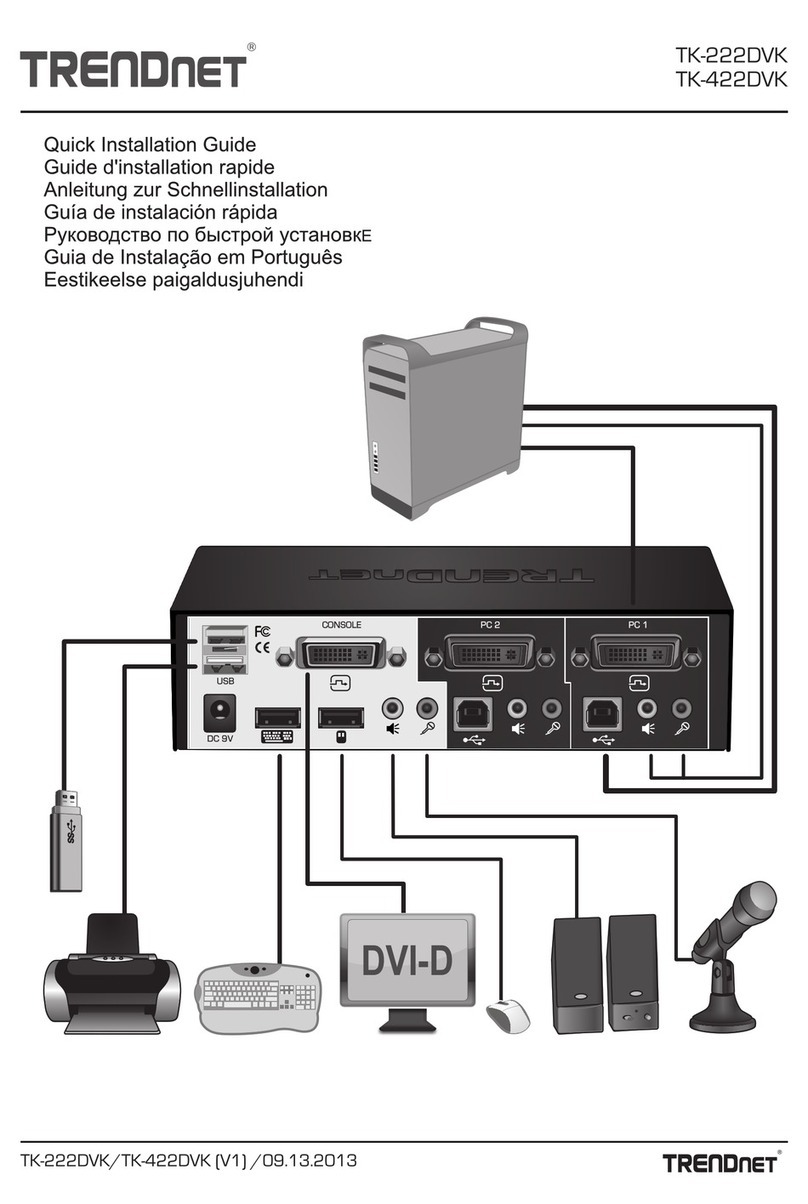
TRENDnet
TRENDnet TK-222DVK Quick installation guide

FIBERROAD
FIBERROAD 7 Series Quick installation guide
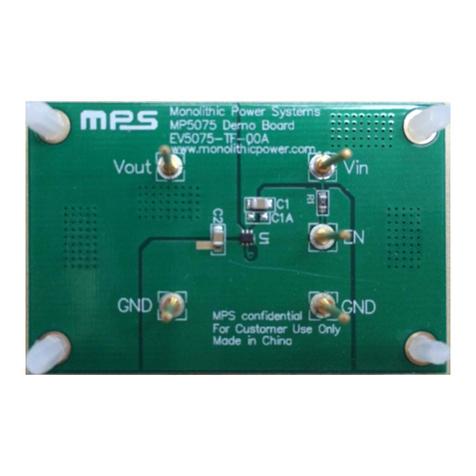
MPS
MPS EV5075-TF-00A manual
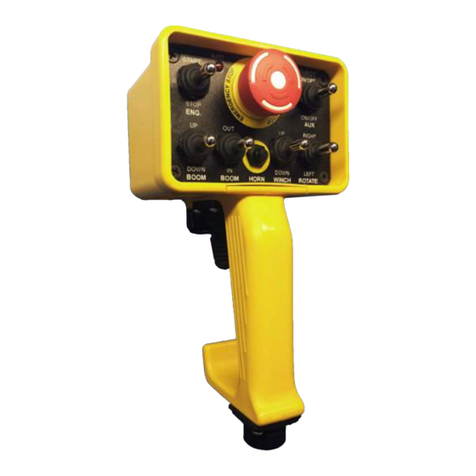
base engineering
base engineering FHSTP Series Installation and operating instructions
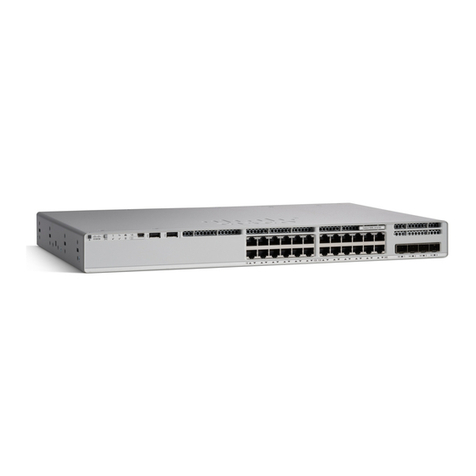
Cisco
Cisco C9200L-24T-4X-A Hardware installation guide
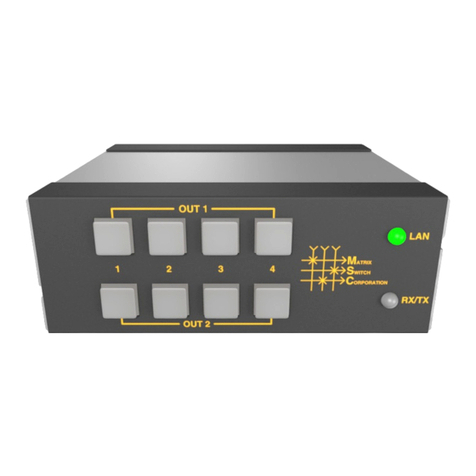
Matrix Switch Corporation
Matrix Switch Corporation MSC-HD42L product manual
